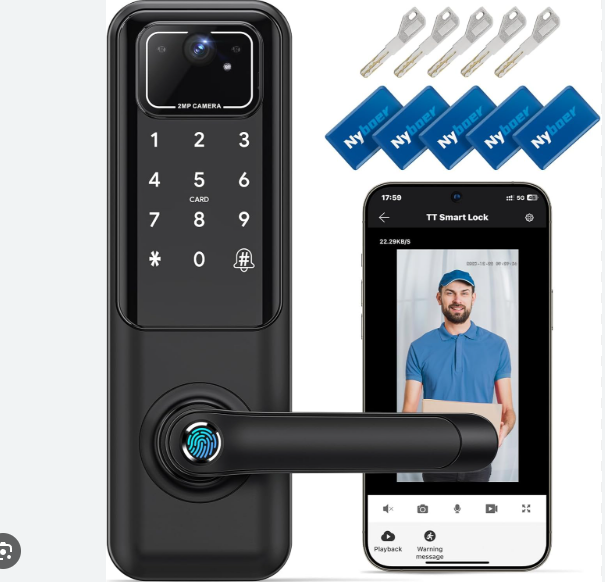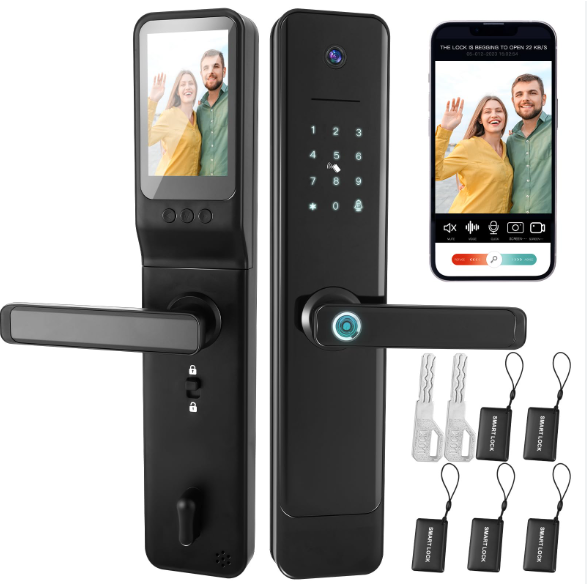The smart lock industry is experiencing explosive growth in 2025, driven by advancements in IoT, AI, and consumer demand for enhanced home security and convenience. As smart locks become a cornerstone of the smart home ecosystem, new technologies, market trends, and product launches are shaping the future of access control. In this comprehensive guide, we’ll dive into the latest smart lock industry news for 2025, covering innovations, market growth, and practical smart lock tips for installation, setup, and maintenance. Whether you’re a homeowner, renter, or business owner, this article will help you stay informed and choose the best smart lock for your needs.
The Smart Lock Industry in 2025: Market Growth and Trends
The global smart lock industry is booming, with projections indicating significant growth through 2030. According to recent reports, the market was valued at approximately USD 3.23 billion in 2025 and is expected to reach USD 6.61 billion by 2030, growing at a compound annual growth rate (CAGR) of 15.4%. Some sources estimate even higher growth, with valuations potentially reaching USD 18.2 billion by 2035 at a CAGR of 15.1%. This surge is fueled by increasing adoption of smart home ecosystems, rising security concerns, and technological advancements in connectivity and authentication. Smart Lock Choice provides detailed guides to help you navigate this rapidly evolving market.
Key trends driving the smart lock industry in 2025 include:
-
- IoT and AI Integration: Smart locks are increasingly incorporating IoT-enabled features for remote control and real-time monitoring, with AI enhancing security through behavior recognition and anomaly detection.
- Biometric Authentication: Fingerprint, facial recognition, and palm-vein scanning are gaining traction for their speed and security, with products like Tapo’s PalmKey leading the way.
- Matter and Thread Standards: The adoption of Matter-over-Thread protocols is improving interoperability, reducing vendor lock-in, and extending smart lock battery life to over 12 months.
- Contactless Solutions: Post-COVID demand for touchless entry continues to drive adoption, particularly in residential and hospitality settings.
- Commercial and Hospitality Growth: The commercial sector, including hotels and offices, is expected to see the fastest growth (CAGR of 25% from 2025–2033), driven by centralized access control needs.
These trends highlight the smart lock industry’s shift toward smarter, more secure, and user-friendly solutions, making 2025 a pivotal year for adoption.

Recent Innovations in the Smart Lock Industry
The smart lock industry in 2025 is marked by groundbreaking product launches and technological advancements. Here are some of the most notable developments:
-
-
- Salto Systems’ XS4 One S Keypad (February 2025): Salto introduced the XS4 One S Keypad, featuring PIN code access, smart keycards, and mobile access with BLUENet Wireless technology. Its backlit, capacitive touch keypad enhances usability, making it a versatile choice for residential and commercial applications.
- Yale’s Matter-over-Thread Deadbolt (March 2025): Yale launched a deadbolt supporting the Matter-over-Thread standard, offering lower power consumption and seamless integration with smart home platforms like Google Home and Amazon Alexa. This lock improves smart lock battery life and interoperability.
- U-tec’s Ultraloq Bolt (2025): U-tec released the Ultraloq Bolt with AI-powered Ultra-Wideband (UWB) and NFC technology, enabling hands-free unlocking as users approach the door. This lock exemplifies the push toward contactless, AI-driven solutions.
- August Home’s Biometric Smart Locks (January 2025): August Home introduced smart locks with biometric fingerprint scanning, enhancing security and convenience for homeowners.
- Schlage’s Commercial-Grade Smart Locks (May 2024): While launched in 2024, Schlage’s multi-factor authentication locks for businesses continue to gain traction in 2025, offering robust security for high-traffic environments.
-
These innovations showcase the smart lock industry’s focus on advanced authentication, energy efficiency, and seamless smart home integration, ensuring smart lock safety and convenience.
Smart Lock Installation and Setup: Best Practices for 2025
As new smart locks hit the market, proper smart lock installation and smart lock setup are critical to maximizing their benefits. Here’s how to ensure a smooth process:
Smart Lock Installation Tips
Most smart locks are designed for DIY installation, typically taking 15–30 minutes with a screwdriver. To ensure success:
-
-
- Check Door Compatibility: Verify your door’s thickness (1-3/8 to 1-3/4 inches) and bore hole sizes (2-1/8-inch for the lock body, 1-inch for the latch).
- Follow Manufacturer Instructions: Align the lock and strike plate precisely to ensure smooth operation of both digital and manual components.
- Test Thoroughly: After installation, test the lock’s digital features (e.g., app control, PIN codes) and manual override (e.g., physical key or thumb-turn).
- Hire a Professional if Needed: For complex installations, such as on metal doors or in commercial settings, consult a locksmith to avoid misalignment.
-
Smart Lock Setup for Connectivity
To connect a smart lock to your smart home ecosystem, follow these steps:
-
-
- Download the Companion App: Install the lock’s app (e.g., August Home, Yale Access) and follow the instructions to pair the lock with your Wi-Fi or a hub.
- Enable Secure Pairing: Use a strong password and enable two-factor authentication (2FA) to protect your lock’s app and smart home accounts.
- Integrate with Smart Home Platforms: How to pair a smart lock with Google Home, Amazon Alexa, or Apple HomeKit varies by model, but most involve linking the lock’s service in the platform’s app.
- Test Remote Access: Confirm you can lock, unlock, and monitor the lock remotely via the app or voice commands.
-
Proper setup ensures your smart lock integrates seamlessly with your smart home while maintaining smart lock safety.
Smart Lock Battery Life and Maintenance in 2025
Smart lock battery life remains a critical consideration, especially with Wi-Fi-enabled models that consume more power. Most smart locks use AA or AAA batteries, lasting 6–12 months, but 2025 innovations like Matter-over-Thread are extending battery life to over a year. Smart lock maintenance tips include:
-
-
- Monitor Battery Levels: Check battery status every 3–6 months via the lock’s app and replace batteries promptly when low.
- Use High-Quality Batteries: Opt for alkaline or lithium batteries as recommended by the manufacturer.
- Backup Power Options: Choose locks with 9V battery terminals or USB ports for emergency power.
- Lubricate Mechanical Components: Use graphite-based lubricant on key cylinders or bolts to prevent sticking.
- Update Firmware: Regularly update the lock’s firmware to patch security vulnerabilities and improve performance.
-
These practices ensure reliability and prevent lockouts, especially for locks integrated with power-hungry smart home systems.
Smart Lock Troubleshooting: Addressing Common Issues
With new technologies in 2025, smart lock troubleshooting is essential to maintain functionality. Common issues and solutions include:
-
-
- Connectivity Problems: If the lock doesn’t respond to app or voice commands, restart the lock, router, or hub, and check Wi-Fi signal strength.
- Battery Drain: Rapid battery depletion may indicate a firmware issue or excessive Wi-Fi use. Update firmware or switch to a Thread-enabled lock for better efficiency.
- Mechanical Jamming: If the bolt or key cylinder sticks, lubricate it or check for misalignment from improper installation.
- App Errors: Reinstall the lock’s app or re-pair the lock with your smart home platform if commands fail.
-
Refer to the manufacturer’s troubleshooting guide or contact support for persistent issues to ensure your lock remains secure and functional.
Smart Lock Safety: Addressing Security Concerns in 2025
As the smart lock industry grows, so do concerns about cybersecurity and physical security. To ensure smart lock safety, consider these precautions:
-
-
- Use Strong Encryption: Choose locks with AES-128 or AES-256 encryption to secure data transmission.
- Enable 2FA: Protect your lock’s app and smart home accounts with two-factor authentication.
- Secure Wi-Fi Networks: Use WPA3 encryption for your home Wi-Fi to prevent hacking attempts.
- Physical Security: Select locks with high ANSI/BHMA ratings (e.g., Grade 1 or 2) for tamper resistance.
- Monitor Activity Logs: Regularly check access logs in the lock’s app to detect unauthorized access attempts.
-
These measures address vulnerabilities like hacking or tampering, ensuring your smart lock remains a secure part of your home.

Portable Smart Locks: A Growing Trend in 2025
Portable smart locks are gaining popularity in 2025, especially for renters and travelers. These locks attach to the interior side of a door without permanent modifications, offering keyless entry via PIN codes or apps. Recent models, like those from August and Yale, support Wi-Fi bridges for smart home integration, making them ideal for apartments or temporary setups. Their flexibility and ease of smart lock installation make them a key trend in the smart lock industry.
Regional Insights: Where the Smart Lock Industry Is Thriving
The smart lock industry shows varied growth across regions in 2025:
-
-
- North America: Dominating with a 39.5% market share in 2024, the U.S. leads due to high smart home adoption and security concerns. The U.S. market alone is projected to reach USD 2.33 billion by 2029 (CAGR 15.16%).
- Asia-Pacific: Expected to grow at the fastest rate (CAGR over 24%), driven by urbanization, rising incomes, and smart city initiatives in China, India, and South Korea. Companies like Desman in China are leading with advanced biometric locks.
- Europe: Significant growth is expected due to demand in residential and hospitality sectors, with brands like Nuki expanding their presence.
-
These regional dynamics highlight the global appeal of smart locks and their role in modern security solutions.
Smart Lock Use Cases in 2025
The smart lock industry serves diverse applications, with 2025 innovations catering to specific needs:
-
-
- Residential: Homeowners prioritize smart locks for keyless entry, remote access, and integration with systems like Google Home or Alexa. Deadbolts dominate with a 46.1% market share due to their security and retrofit compatibility.
- Hospitality: Hotels and vacation rentals adopt smart locks for contactless check-ins and remote access management, with a projected CAGR of 17.1% through 2030.
- Commercial: Businesses use smart locks for centralized access control, with lever handles gaining traction for high-traffic settings (CAGR 23% from 2025–2033).
-
Conclusion: The Future of the Smart Lock Industry in 2025
The smart lock industry in 2025 is defined by rapid innovation, with AI, biometrics, and Matter-over-Thread standards driving growth. From Yale’s energy-efficient deadbolts to U-tec’s hands-free Ultraloq Bolt, new products are enhancing convenience and smart lock safety. By following best practices for smart lock installation, smart lock setup, and smart lock maintenance, users can maximize the benefits of these advanced devices. Whether you’re upgrading your home security or managing a commercial property, staying informed about smart lock industry news ensures you choose the right lock for your needs. For more insights and recommendations, explore the comprehensive resources at Smart Lock Choice to find the best smart lock guide for 2025.